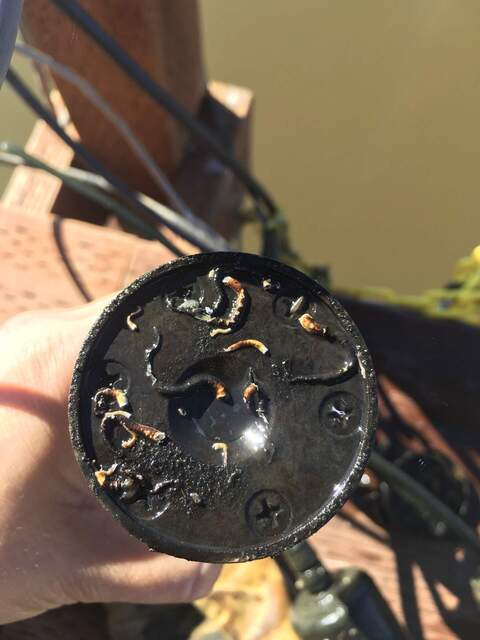Field Notes
<--2022-09-16 07:45:00 | 2022-10-05 09:15:00-->Other sites visited today: Bouldin Corn | Bouldin Alfalfa
Phenocam link: Searching...
Hill Slough: 2022-09-29 09:10:00 (DOY 272)
Author: Daphne Szutu
Others: Ari
Summary: Regular data collection/cleaning, only a slight breeze, redeployed EXO after calibration and wired to CR23x, removed miniDOT for cleaning, picam power cable corroded--fixed, cleaned precip bucket
| 2022-09-29 Hill Slough Ari and I arrived at 9:10 PDT. For once it was not windy at all, just the slightest breeze on a mild and sunny day. Nice visibility. The tide is going out and the low tide today is around 11 PDT. There were many wading birds, such as stilts, ducks, and egrets. We started at the channel to redeploy the EXO sonde sn 22C103416 along with sensors: Turbidity sn 22E106072 FDOM sn 22E100649 pH-ORP sn 22D102641 (We are still waiting for delivery of the conductivity/temperature sensor) In the lab, Ari had cleaned the sonde and sensors, put on fresh plastic sheaths, and calibrated all the sensors. I had converted the field cable to a flying lead cable (easy! just cut off the fancy connector end!) and wired the cable to the EXO DCP Signal Adapter 2.0 sn ??. This converts the EXO output to SDI-12, where it can be stored on the CR23X. All the CR23X data at the channel (EXO, eosGP, CTD) are sent to the main met CR1000. I wired the EXO signal adapter to C7 on the CR23X and uploaded a new program that adds the EXO channels. We lowered the EXO into the water and started the deployment via the Kor software. No depth sensor was recognized--it did not show up in the Kor sensor list or in the real-time data. This is weird because the depth sensor is internal to the sonde, so there should not be any connection issues. We tried sending an older deployment configuration, but we were still "missing" the depth sensor. At this point we pulled the whole thing out of the water and power cycled it. Upon restart, the depth sensor worked and we could see real-time depth data. We calibrated the depth sensor (guessing temperature = 22C) on the boardwalk before lowering the EXO into the water again. We sent the updated deployment config (HS_23x_channel?) and confirmed the Kor real-time data looked reasonable. The sonde is measuring and storing data every 5 minutes. We then checked the EXO data on the CR23X. When the EXO was connected to cable power, all the data seemed reasonable. However, if it was powered only through the DCP Signal Adapter, sonde power = -INF and everything else would be 0. The DCP Signal Adapter power cable had a 1A surface mount fuse soldered on as per the Signal Adapter manual. We tried 2 different fuses; both had connectivity on both ends of the power cable. Joe said it's possible that we need a different type of fuse (blade, glass tube) for whatever reason. It's also possible there is some loose or bad connection between the fuse, fuse holder, and power cable which can't handle the amount of current being drawn and connectivity breaks. We decided to power it with a power cable without a fuse for now. The CR23X real-time data seemed reasonable; it updates about 1:30min after the 5-min mark. We pulled up the eosGP and miniDOT to inspect them. Lots of shrimp under and on top of the copper screens, and some barnacles on both sensor bodies. I meant to put a new desiccant minipak in the miniDOT since I ran out last time, but there was some calcareous deposit (encrusting worm?) on the sensing foil, so I brought the miniDOT sn 931528 back to the lab for cleaning. Ari had heard the idea of using nylons (women's hoisery) to cover water sensors instead, so maybe we can try that. The fine weave size might prevent the shrimp from getting in, and the slipperiness might prevent other organisms from attaching. I rinsed off as many shrimp as possible from the eosGP and put both its copper screen and the miniDOT copper screen on it to see if that would help prevent shrimp from passing through. We started work at the main tower around 10:56 PDT. At this point the water was below the staff gauge, so no reading to report today. I downloaded met and USB GHG data. After downloading data, I sent a new CR1000 program to the main met datalogger that adds in the EXO channels and stores them in the 30-min data table. The 5-min data is still stored on the sonde's internal memory if needed. I changed the eddy clock +30sec from 10:03 to 10:03:30 and restarted logging. Ari cleaned flux and rad sensors. The wash reservoir was 75% full; she refilled it. She also took a water sample from the sipper to measure for conductivity later. Sample, temperature-compensated conductivity, temperature, notes Porewater, 20.96 mS,,Sample stored in fridge before being measured 10:37 PST The precip bucket funnel was plugged with bird poop; Ari cleaned it out and reinstalled the funnel. The picam was not showing up in the network. The picam cable was mostly out of the conduit between the upper boardwalk and the camera (maybe that's normal), and there were 2 places in the picam power cable that were slightly chewed and corroded. I unplugged the picam power cable and trimmed the cable back; luckily there was enough extra cable to reach. I restarted the camera and stuffed as much of the power cable into the conduit as possible. There are only 2 days of camera photos. The camera POV might be slightly shifted after all the tinkering. We leveled its view as much as possible. We returned to the channel afterwards to make final height adjustments to the instruments. Ari got in the water with waders to make height measurements around 10:55 PST. Fluffy soil surface to EXO handle base = 103cmBottom of EXO guard to EXO handle base = 63.5cm (so water quality sensors are about 40cm above fluffy soil surface) Depth sensor to water surface ~22cm (water level can decrease about 20cm before depth sensor is out of water; today's low tide ~1.3ft) Ari also adjusted the miniDOT and eosGP so they're at the same depth as the EXO water quality sensors, +/- 2cm. The 7500 read: 404ppm CO2, 699mmol/m3 H2O, 22.0C, 101.9kPa, 96SS -- 100 after cleaning The 7700 read: 1.9ppm CH4, 40RSSI – 73 after cleaning We left at 12:10 PDT. |
1 photos found

20220929HS_DepositsMD.jpg ( 2022-09-29 09:39:09 ) Full size: 1440x1920
Calcareous deposits on the miniDOT, despite the copper screen that was in place.
4 sets found
21 HS_met graphs found
4 HS_flux graphs found
1 HS_cam graphs found
Can't check HS_Processed
2 HS_Processed graphs found

